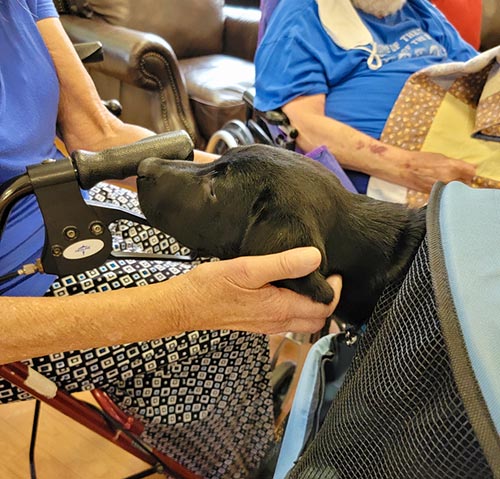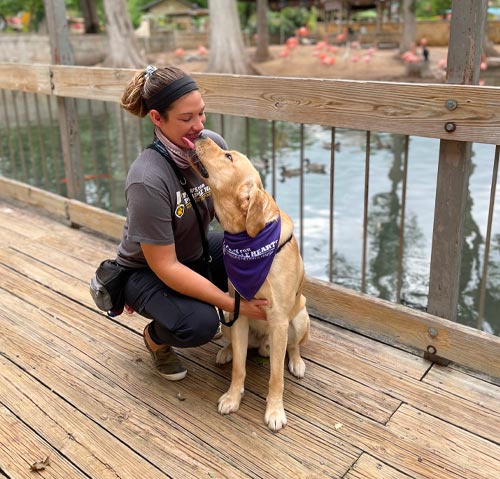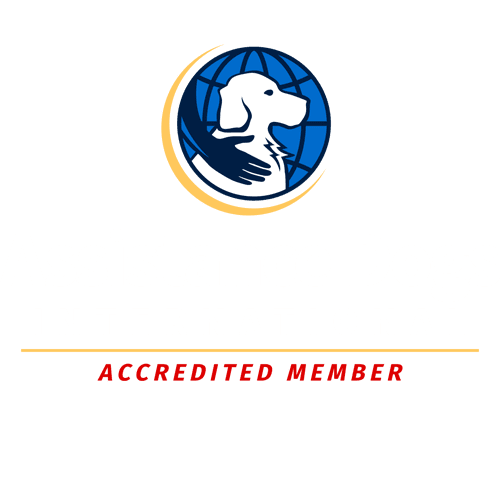5 Frequently Used Service Dog Commands
At Paws for Purple Hearts we work every day to train and provide the highest quality assistance dogs and canine-assisted therapeutic programs. Our service dogs learn over 100 commands making them more than capable of serving the most demanding category of mobility impaired Warrior, a quadriplic-level patient. This provides the Military Caregiver (Family) dramatic respite and logistical relief because our dogs can carry out many routine, repetitive and physically demanding tasks that would otherwise have to be accomplished by the Caregiver, including picking up dropped objects, retrieving items, opening refrigerator doors, drawers, and cabinet doors, assisting with undressing, switching lights and other devices on and off, opening and closing doors, providing assistance moving to and from wheelchairs, helping support patients climb and descend stains and alerting others when help is needed, all while providing loving and devoted companionship as a welcome addition to the family.
Top 5 Training Commands
While we train our service dogs-in-training to learn a wide variety of commands, there are a handful that are more commonly used than others. Some of our more basic commands that are frequently used include: “Leave It,” “Let’s Go,” “No,” “Wait,” and “Stay.” These commands are used daily in training and sessions and create a foundation for the dogs as they go through the over 100 commands they will ultimately learn at the end of their two and a half years of training and preparation. Of those commands, the two that are probably used the most are “Wait” and “Stay.” These commands are used/can be used at any given time in training. “Wait” and “Stay” are often used when being released from the kennels, when waiting for a secondary command, or when a handler needs their service dog to stay put momentarily. The “No” command lets the service dog-in-training know that they have done the wrong command or if they are behaving incorrectly. It allows the service dog-in-training to understand and correct themselves accordingly. Lastly, the “Leave It” and “Let’s Go” commands are essential for field trips and outings. The command “Leave It” allows the handler to let the service dog-in-training know to leave that item, person or other animal alone and it also tells them to keep their focus on the handler or the task at hand.

The Key Differences between Mobility Commands and PTSD Commands
Just like there are basic training commands, there are also commands that are specifically designed and used for mobility assistance purposes and targeted for those with Post-Traumatic Stress Disorder (PTSD) and/or a Traumatic Brain Injury (TBI). Mobility assistance commands are used to help those with physical restrictions or difficulties. So to address these restrictions, our service dogs learn to assist their handler with physical movements like turning on the lights, picking up items that have fallen and giving them back, or retrieving items like medicines. Commands that are designed to assist those with PTSD and TBI often are used to relieve mental and emotional stressors. Our dogs learn commands that recognize and interrupt nightmares, relieve stress and anxiety from the handler by nudging and grounding them/getting their focus away from the stress itself, and grounding them by applying pressure to their body when lying down or snuggling. These are only a small portion of what our dogs ultimately learn during their preparation.
Lending a Paw
As mentioned above, all of our dogs-in-training learn a wide variety of commands to meet the different needs of their future Warrior. Some commands targeted specifically towards mobility assistance that are frequently used are: “Get It,” “Tug,” “Heel/Side,” “Touch/Here,” and “Go to Bed.” The commands “Get It” and “Tug” are specifically used for retrieving items and opening doors respectively. These commands allow the handler to avoid having to reach for items that have fallen to the ground or open doors as they are trying to maneuver their wheelchair, cane or other assistance equipment. The commands “Heel/Side” and “Touch/Here” are regularly used to adjust the dog to a new placement that is more convenient for the handler. “Heel/Side” lets the dog know to stand right beside the handler, flush with their stance, so that they are not in the way of the handler walking. “Touch/Here” allows the handler to position the dog in a different direction or location so that they are not in the way of others around them, like in a hallway or at a restaurant. Lastly, “Go to Bed” is just as it sounds; it lets the dog know to go to their bed, lay down, and await the next command.
Having a Paw to Lean On
Some, if not all, of these commands are also regularly used to assist those with PTSD and TBI. However, other commands used include: “Nudge,” “Lap/Visit,” and “Snuggle.” All of these commands are used and focused on relieving any stress and anxieties the handler may be feeling. “Nudge” is often used when the dog detects higher levels of anxiety. Signs of heightened anxiety include bouncing one’s knee while seated, and nervous fidgeting. In cases like this, the dog knows to nudge the handler until their attention is focused on the dog and away from the cause of stress or anxiety. The command “Lap/Visit” is used for snuggles/hugs and for greeting others. “Lap” lets the dog know to put their front paws on their handler’s lap. This allows them to then snuggle, give kisses, or just add pressure to the handler’s body and relieve anxiety and stress. “Visit” is used to greet other people and teaches the dog-in-training the appropriate behavior when saying hello or meeting new people. Lastly, the command “Snuggle” is just like the name suggests; “Snuggle” is used for snuggles! The bond between a service dog and its handler becomes a strong one, so having that contact can reduce stress and depression.






 Combined Federal Campaign (CFC) #43093
Combined Federal Campaign (CFC) #43093